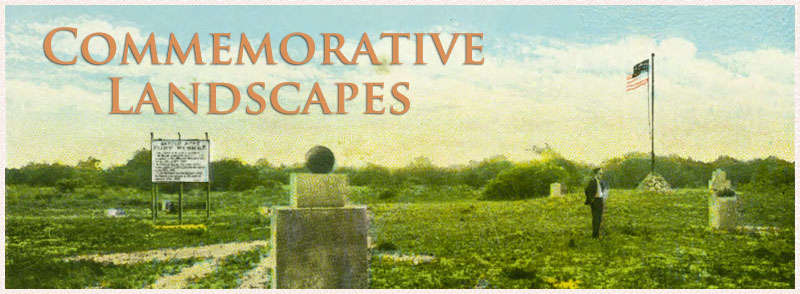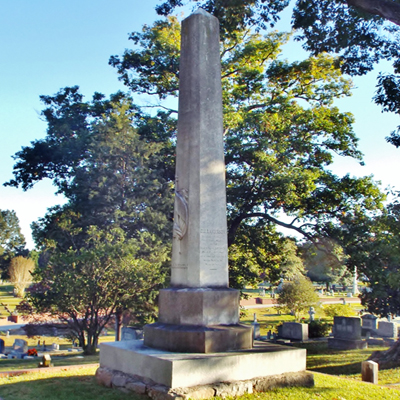
Gen. George Burgwyn Anderson, Oakwood Cemetery, Raleigh
The marble monument to General George Burgwyn Anderson is an obelisk standing on a three tier base
sitting on a rock and concrete foundation. Inscriptions appear on the south and north face of
the obelisk. In relief on the east face is a sword incised in a decorative scabbard. In relief on the
west face appears a furled Confederate battle flag.
Images:
South face inscription |
North face inscription |
Confederate battle flag |
Sword |
Signature of stone cutters
South Face: GEO. B. ANDERSON / BRIGADIER GENERAL / CONFEDERATE STATES / ARMY / BORN
APRIL 12th, 1831. / DIED OCTOBER 16TH, 1862 / OF A WOUND RECEIVED / AT THE BATTLE /
SHARPSBURG
North Face: SEVEN PINES. / MECHANICSVILLE. / COLD HARBOR. / MALVERN HILL. / SOUTH
MOUNTAIN. / SHARPSBURG.
West Face, beneath furled flag: ANDERSON
Oakwood Cemetery
Erected in May, 1868
35.785550 , -78.627380
View in Geobrowse
"Special Format Image 0129: Monument to General Anderson (Oakwood Cemetery), circa 1872-1873," in the Rufus Morgan Photographic Collection #P0057, North Carolina Collection Photographic Archives, The Wilson Library, University of North Carolina at Chapel Hill, (accessed November 6, 2015) Link
The Wilmington Morning Star (Wilmington, NC), May 21, 1868, 2
Historic Oakwood Cemetery, http://historicoakwoodcemetery.org (accessed May 19, 2021) Link
Wert, Jeffry D. "Anderson, George Burgwyn. 12 Apr. 1831–16 Oct. 1862," NCPedia.org, (accessed November 6, 2015) Link
“Anderson,” The Historical Marker Database, HMdb.org, (accessed October 25, 2015) Link
“George Burgwyn Anderson,” Find A Grave, (accessed October 16, 2015) Link
Yes
Marble
General Anderson was wounded at the battle of Sharpsburg (Antietem) in Maryland on
September 17, 1862. This was the bloodiest single day of combat during the Civil War. After the
battle Anderson was carried to Richmond and then to Raleigh where he had a foot amputated
on October 15th. He died of shock the next day.
Although a career military officer, Anderson was raised on a plantation with slaves near Hillsboro. [Additional information from NCpedia editors at the State Library of North Carolina: Many Black and African people, their descendants, and some others were enslaved in the United States until the Thirteenth Amendment abolished slavery in 1865. It was common for wealthy landowners, entrepreneurs, politicians, institutions, and others to enslave people and use enslaved labor during this period. To read more about the enslavement and transportation of African people to North Carolina, visit https://aahc.nc.gov/programs/africa-carolina-0. To read more about slavery and its history in North Carolina, visit https://www.ncpedia.org/slavery. - Government and Heritage Library, 2023.]
Historic Oakwood Cemetery was founded in 1869 in North Carolina's capital, Raleigh, near the North Carolina State Capitol in the city's Historic Oakwood neighborhood. Annual Confederate Memorial Day services are held at the Oakwood Cemetery each May.
The memorial is located in Historic Oakwood Cemetery, at 701 Oakwood Ave, Raleigh, NC 27601, in Confederate section. The Memorial Arch, House of Memory, Confederate Monument, Memorial Wall, Gettysburg Memorial, Colonel McLeod Turner Monument, Col. Burgwyn Monument, CSS H.L. Hunley Submarine Memorial, Randolph Shotwell Memorial, Arlington Dead Marker and the Civil War Sesquicentennial Marker stand in the same section of the Oakwood Cemetery. Outside the Confederate section are memorials to Worth Bagley and William Ruffin Cox.
The memorial is surrounded by grave markers and monuments.
Yes
The Oakwood Cemetery continues to serve for Confederate Memorial Services each Memorial Day.
 Know anything else about this monument that isn't mentioned here? If you have additional information on
this or any other monument in our collection fill out the form at the Contact Us link in the footer. Thank you.
Know anything else about this monument that isn't mentioned here? If you have additional information on
this or any other monument in our collection fill out the form at the Contact Us link in the footer. Thank you.

